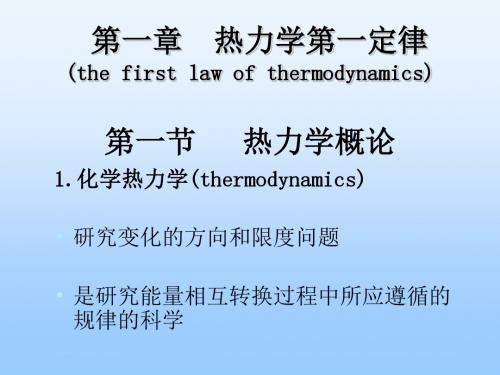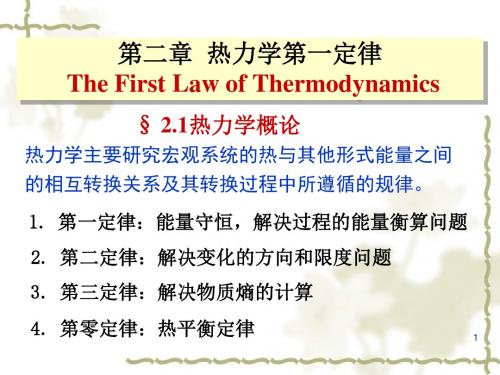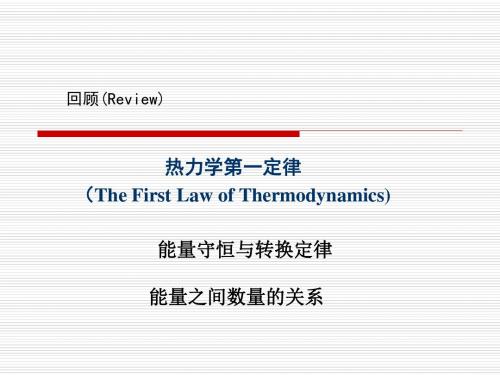The first law of thermodynamics 热力学第一定律
- 格式:doc
- 大小:34.50 KB
- 文档页数:5






热力学第一定律科技名词定义中文名称:热力学第一定律英文名称:first law of thermodynamics其他名称:能量守恒和转换定律定义:热力系内物质的能量可以传递,其形式可以转换,在转换和传递过程中各种形式能源的总量保持不变。
概述热力学第一定律热力学第一定律:△U=Q+W。
系统在过程中能量的变化关系英文翻译:the first law of thermodynamics简单解释在热力学中,系统发生变化时,设与环境之间交换的热为Q(吸热为正,放热为负),与环境交换的功为W(对外做功为负,外界对物体做功为正),可得热力学能(亦称内能)的变化为ΔU = Q+ W或ΔU=Q-W物理中普遍使用第一种,而化学中通常是说系统对外做功,故会用后一种。
定义自然界一切物体都具有能量,能量有各种不同形式,它能从一种形式转化为另一种形式,从一个物体传递给另一个物体,在转化和传递过程中能量的总和不变。
英文翻译:The first explicit statement of the first law of thermodynamics, byRudolf Clausiusin 1850, referred to cyclic thermodynamic processes "In all cases in which work is produced by the agency of heat, a quantity of heat is consumed which is proportional to the work done; and conversely, by the expenditure of an equal quantity of work an equal quantity of heat is produced."基本内容能量是永恒的,不会被制造出来,也不会被消灭。
The first law of thermodynamics 热力学第一定律
(20)Thermodynamics is a macroscopic science, and at its most fundamental level, is the study of two physical quantities, energy and entropy. Energy may be regarded as the capacity to do work, whilst entropy maybe regarded as a measure of the disorder of a system. Thermodynamics is particularly concerned with the interconversion of energy as heat and work.
热力学是一门宏观的科学,它在最基本的水平上对能量和熵两个物理量进行了研究。
能量可以认为是做功的能力,而熵是一个体系混乱度的测量。
能量以热和功的形式所进行的相互转变是热力学特别关心的。
In the chemical context, the relationships between these properties may be regarded as the driving forces behind chemical reactions. Since energy is either released or taken in by all chemical and biochemical processes, thermodynamics enables the prediction of whether a reaction may occur or not without need to consider the nature of matter itself.
在化学范围中,这些性质之间相互关系可以认为是化学反应的驱动力。
因为在所有化学和生物化学过程中,能量要么被释放,要么被吸入。
热力学可以预言一个反应能否发生而不需考虑物质本身的性质。
Consideration of the energetics of a reaction is only one part of the story. Thermodynamics determines the potential for chemical change, not the rate of chemical change---that is the domain of chemical kinetics.
考虑反应的动能学仅仅是研究化学反应的一部分。
热力学决定了一个化学变化的潜能,而不是化学变化的速度,即化学变化是动力学研究的范围
Internal energy内能
(21)A fundamental parameter in thermodynamics is the internal energy denoted as U. This is the total amount of energy in a system, irrespective of how that energy is stored. Internal energy is the sum total of all kinetic and potential energy within the system.
内能是动力学的一个基本参数,用U表示。
它是体系的总能量,与能量的储存方式无关。
内能是体系内所有动能和势能的总和。
(22)Work is the transfer of energy as orderly motion. In mechanical terms, work is due to energy being expended against an opposing force. The total work is equal to the product of the force and the distance moved against it. Work in chemical or biological system generally manifests itself in only a limited number of forms. Those most commonly encountered are pressure-volume (PV) work and electrical work.
功是有序运动所引起的能量转移。
按物理学的术语,功是对抗相反的力所消耗的能量。
总的功等于力和对抗该力所移动的距离的乘积。
在化学和生物体系中,功以有限的形式显示。
最常碰到的功是压力-体积功(PV)和电功。
(23)Heat is the transfer of energy as disorderly motion as the result of a temperature difference between system and its surroundings. When energy is put into a system, there is usually a corresponding rise in the temperature of that system. Assuming that the energy is put in only as heat, then the rise in temperature of a system is proportional to the amount of heat which is input into it.
热是由于体系与环境之间的温差造成的无序运动引起的能量转移。
当能量输入一个体系时,体系的温度通常相应会升高。
加入一个体系仅仅以热得形式输入,那么一个体系升高的温度与输入的热量成正比。
The first law
(24)The first law of thermodynamics states that “The total energy of an isolated thermodynamic system is constant”. The law is often referred to as the conservation of energy, and implies the popular interpretation of the first law, namely that “energy cannot be created or destroyed”. In other words, energy may be lost from a system in only ways, either as work or as heat. As a result of this, it is possible to describe a change in the total internal energy as the sum of energy lost or gained as work and heat, since U cannot change in any other way. Thus, for a finite change: △U=Q+W. Where Q is the heat supplied to the system, and W is the work done on the system.
热力学第一定律认为“孤立的热力学体系的总能是恒定的”。
这一定律通常认为是能量守恒定律,它表达了第一定律的通俗解释,即“能量既不能被创造,也不能被消灭”。
换句话说,能量只能以两种方式,功或热得方式,从一个体系中失去。
因此,以失去或得到的功和热得能量的总和来描述总能的改变时可行的。
因为U不能以别的形式改变。
因此,内能的有限形式的改变为:△U=Q+W。
其中Q是提供该体系的热,而W是对体系所做的功。